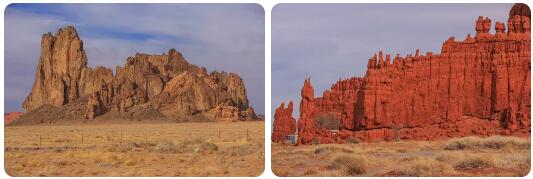
Apache County, Arizona is a large county located in the northeast corner of the state. It is bordered by New Mexico to the east, Utah to the north, Coconino County to the west and Navajo County to the south. Apache County is one of the seven original counties created by the Arizona Territorial Legislature in 1879. The county seat is St. Johns.
Apache County covers an area of 11,218 square miles and is one of the largest counties in Arizona. It has an estimated population of 71,518 people as of 2019 making it one of Arizona’s least populated counties.
The county’s terrain varies from desert valleys and plateaus in its eastern region to mountain ranges and high-elevation forests in its western region. The county’s highest point is Escudilla Mountain at 10,980 feet above sea level while its lowest point is at 2,400 feet along its eastern border with New Mexico.
Apache County has many natural attractions including Canyon de Chelly National Monument located on Navajo Nation land near Chinle; Petrified Forest National Park near Holbrook; Chiricahua National Monument near Willcox; and Apache-Sitgreaves National Forest which includes several lakes for fishing, camping and other outdoor activities. Other outdoor recreation opportunities include hiking trails throughout Apache-Sitgreaves National Forest as well as four golf courses located throughout the county.
The economy in Apache County relies heavily on agriculture, primarily cattle ranching and farming as well as mining operations for copper and uranium ore extraction from local mines such as Morenci Mine near Clifton-Morenci and Mission Mine near Safford. The county also has a tourism industry with many visitors coming to explore its natural attractions each year as well as experience its unique culture which includes Native American reservations such as Navajo Nation which makes up a large portion of Apache County’s population.
Education opportunities are available through public schools operated by three school districts within Apache County: St Johns Unified School District #1 which serves St Johns, Concho Elementary School District #2 which serves Concho Valley area schools, and Bylas Elementary School District #3 which serves Bylas area schools. Higher education opportunities are available through Eastern Arizona College located in Thatcher or through online courses offered through University of Phoenix or Northern Arizona University eCampus program both based out of Phoenix but offering online courses throughout Arizona including those offered at their satellite campuses located in Show Low or Holbrook respectively within Apache County borders .
Apache County offers residents a unique combination of rural living mixed with modern amenities making it an ideal place for those looking for an escape from city life while still having access to medical care (both hospitals and clinics), shopping centers (including Wal Mart Supercenter locations), restaurants (including fast food options), entertainment venues (including movie theaters), museums (such as Petrified Forest Museum), libraries (such as Pinetop-Lakeside Library), national parks (such as Canyon de Chelly National Monument), golf course resorts (such as Torreon Golf Club )and much more all within easy driving distance from any location within Apache County boundaries.
History of Apache County, Arizon
Apache County, Arizona is located in the northeast corner of the state and is the largest county in terms of land area. It is bordered by New Mexico to the east and Utah to the north. The county was established in 1879 from a portion of Yavapai County and was named after the Apache people who lived in the area for centuries.
The Apache were a nomadic tribe that occupied much of what is now Arizona, New Mexico, and parts of Texas and Oklahoma. They were known for their fierce warrior culture as well as their skill as hunters and gatherers. Apache County was home to many different tribes, including Navajo, Hopi, Zuni, White Mountain Apache, San Carlos Apache, Yavapai-Apache Nation, Chiricahua Apache Tribe, Jicarilla Apache Nation, Mescalero Apache Tribe and Fort Sill Apache Tribe.
The earliest settlers in what would become Apache County arrived in 1876. These settlers were mostly miners looking for silver or copper deposits. As more people moved into the area ranching began to take hold with cattle being grazed on open range land. By 1880 there were several small towns scattered around the county including St Johns which became the county seat when it was created.
In 1881, Fort Apache was established by General George Crook at White River near present day Whiteriver on the Fort Apache Indian Reservation where it still stands today. The fort was used to protect settlers from hostile Native American tribes as well as providing a base of operations for military campaigns against them.
In 1886, President Grover Cleveland signed an executive order establishing what would become known as Navajo National Monument which encompasses three ancient cliff dwellings located near Kayenta in northeastern Arizona which are still accessible today for visitors to explore these important cultural sites from long ago .
Throughout much of its history, mining has been an important part of life in Apace County but it also has been home to many ranches including some that remain active today like The Big Dry Wash Ranch which dates back to 1885 when it was founded by Charles Poston who made his fortune mining gold in Tombstone before moving out west .
Today, most of Apace County’s population lives along its western border with Navajo County while much of the eastern part remains rural and sparsely populated due mostly to its rugged terrain making it difficult for development or farming activities . There are several small towns throughout Apace County today with St Johns remaining its largest city and county seat while Holbrook is another popular town along Route 66 that runs through Apace County.